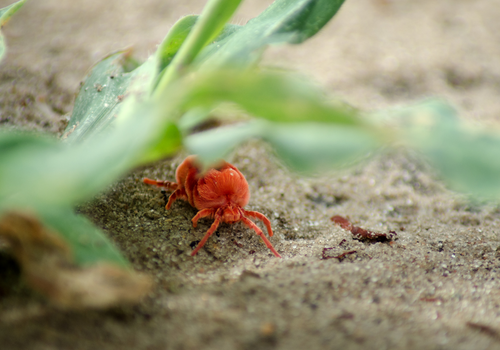Clover mites are very small, red, eight-legged creatures that are related to spiders. These pests are a nuisance because they often invade homes in large numbers. Clover mites do not bite or carry disease, but their presence can be a nuisance.
Clover mites get their name from their preferred habitat: clover fields. However, they are also commonly found in other areas with lots of vegetation, such as parks, gardens, and yards.
When clover mites invade homes, they are often seen on windowsills, curtains, and walls.
Clover mites are most active during the spring and fall. During the winter, they will hibernate in cracks and crevices around homes. In the spring, they will emerge from hibernation and begin to reproduce. A female clover mite can lay up to 50 eggs at a time.
If you find clover mites in your home, there are a few things you can do to get rid of them. Check them out below.
How To Identify Clover Mites On Your Plants
To identify clover mites on your plants, look for small, red, spider-like insects crawling on the leaves or stem. These mites are often found in groups and can be difficult to spot. If you suspect your plant has clover mites, inspect it closely with a magnifying glass.

If you see small, red, spider-like insects crawling on your plant, it is likely that you have clover mites. These pests are often found in groups, so if you see one, there are probably more. To get rid of clover mites, you can vacuum them up or treat your plant with an insecticide.
How To Tell If Your Clover Mite Problem Is Bad Enough To Warrant Professional Help
If your clover mite problem is bad enough that you are considering professional help, there are a few things you can look for to help you make your decision.
Take a look at how many clover mites you are seeing. If you are seeing a large number of mites, especially if they are indoors, then it is probably time to call in a professional.
Another thing to look for is damage to your plants. Clover mites feed on plant sap, so if you see that your plants are starting to look wilted or unhealthy, it is likely due to the mites.
Finally, if you are finding clover mites in areas where they can cause problems for people, such as in beds or on furniture, it is probably time to get professional help.
How To Prevent Clover Mites From Infesting Your Plants
The best way to prevent clover mites from infesting your plants is to keep your plants healthy. Healthy plants are less likely to be infested because they are strong and can resist pests better. To keep your plants healthy, make sure to:
- Water them regularly
- Fertilize them
- Prune them regularly
- Protect them from extreme weather conditions
If you notice that your plants are starting to get infested with clover mites, take immediate action to prevent the infestation from spreading. Some things you can do include:
- Removing infested leaves
- Spraying the plants with insecticide
- Using traps to catch the mites
A Step-by-step Guide To Getting Rid Of Clover Mites On Your Plants
Check your plants for small, red, spider-like creatures. If you see any, they are probably clover mites.
- Spray your plants with water. This will kill some of the mites, but not all of them.
- Mix up a solution of soapy water and dish soap. Spray this on your plants. The dish soap will kill the mites.
- You can also try a mixture of 1 part vinegar to 3 parts water. Spray this on your plants. The vinegar will kill the mites.
- If you have a serious infestation, you may need to use an insecticide. Be sure to read the label and follow the directions carefully. There are different types of insecticides available, so be sure to choose one that is specifically designed to kill mites.
- Vacuuming is also one most effective ways to remove them. You can also seal cracks and crevices around your home to prevent them from entering. If you have a serious infestation, you may need to contact a pest control professional.
Bonus Tips
- Remove clover mites from outdoor plants with a strong stream of water from a hose.
- Pick clover mites off of outdoor plants and drop them into soapy water.
- Apply an insecticide labeled for use against clover mites to outdoor plants.
- Try to remove the mites with a vacuum cleaner.
Frequently Asked Questions
- What do clover mites eat?
Clover mites feed on the sap of plants and can cause damage to both indoor and outdoor plants.
- How can I tell if my plants have been infested with clover mites?
If you see small, red, or reddish-brown creatures on the leaves of your plants, it is likely that they are clover mites. You may also see small, round, reddish-brown spots on the leaves of your plants, which are the mites’ eggs.
- What is the best way to get rid of clover mites?
The best way to get rid of clover mites is to vacuum them up with a strong vacuum cleaner. You can also try spraying your plants with a strong stream of water from a hose, which will remove the mites from the leaves.
Conclusion
If you see small, red bugs crawling on the leaves of your outdoor plants, there’s a good chance they are clover mites. These pests are often found in gardens and can cause damage to your plants. To get rid of them, you’ll need to follow our efficient tips and guides above.